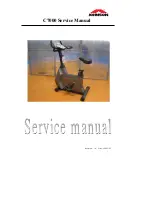
ENGLISH
EN
09
Emergency Brake (4)
The same button you use to adjust the tension of the bike also functions
as an emergency brake. Use this safety feature in any situation where
you would need to stop cycling.
NOTE!
To use the emergency brake function, you must press the
button (52). Firmly press down.
TRAINING WITH HEART RATE
Wireless heart rate receiver (5 kHz)
This VirtuFit fitness equipment is equipped with a wireless heart rate
receiver. For the heart rate measurement with a wireless heart rate
monitor uses a heart rate monitor which works on a 5 kHz frequency.
With a wireless heart rate monitor, it is important that the electrodes
are slightly moist and the heart rate monitor fits well to your body.
Refer to your heart rate monitor's user manual for proper instructions.
Incorrect use of the heart rate monitor may result in abnormal readings.
NOTE!
A wireless heart rate monitor is not included as standard.
Contact your dealer to purchase a wireless heart rate monitor
WARNING!
•
If you have a pacemaker, it is recommended that you consult
your physician before using a wireless heart rate monitor
•
In rooms with multiple heart rate monitors, it is recommended
that you keep enough distance to avoid interference between
different devices.
•
Always try to keep the wireless heart rate monitor within a
range of 1 meter from the console for optimal reception.
•
Always wear a wireless heart rate monitor directly on the
body, under clothing.
MAINTENANCE
Safe and efficient use can only be achieved if the appliance is
properly installed and maintained. It is your responsibility to ensure
that the appliance is maintained regularly. Parts that have been
used and/or damaged must be replaced before the appliance is
used again. The appliance should only be used and stored indoors.
Long-term exposure to weather and temperature/humidity changes
can have a serious impact on the electrical components and moving
parts of the unit. Always unplug the power cord from the unit before
cleaning or servicing it.
ADJUSTING (FIG. B, 1-4)
Saddle adjustment (1)
In order to train effectively, it is advisable to adjust the saddle to the
correct height. When pedalling, your knees should be slightly bent
when the pedals are in the down position.
To adjust the saddle, follow the steps below:
To adjust the seat height, turn the spring-loaded knob on the seat
post on the frame and tighten it. Position the vertical seat post at the
desired height so that the holes are aligned, release the button and
tighten firmly. To move the saddle forwards towards the handlebars
or backwards away from the handlebars, turn the adjusting knob and
ring and tighten the knob again. Slide the horizontal seat post into the
desired position. Set the pin in the holes and then tighten the adjusting
knob.
Handlebar adjustment (2)
To adjust the handlebar, follow the steps below:
Rotate the knob and secondary knob and pull both knobs. Slide the
handlebar post along the housing on the main frame to the desired
height and with the holes correctly aligned, tighten the spring button
and then the secondary button.
Resistance knob (3)
To ensure a smooth and efficient pedaling motion, the resistance is
adjusted at the factory during production.
Setting the resistance
By increasing or decreasing the tension, you can add variety to your
training sessions by adjusting the resistance of the bicycle. To increase
the tension and increase the resistance (which provides more power to
the pedal), turn the resistance knob (52) to the right. To decrease the
tension and to decrease the resistance (which gives less force to the
pedal), turn the resistance knob (52) to the left.
Piept het toestel bij het verhogen van de weerstand?
The block may have dried out, causing a squeaking sound. If so,
lubricate the felt pad a little with the supplied silicone oil.
NOTE!
It is recommended to start training at a level that suits your
own needs. Remember to start slow and gentle and work your way
up to the level that suits you.
Summary of Contents for Etappe 1
Page 2: ...USER MANUAL 02 TOOLKIT Inner hexagon spanner Crosshead Spanner 6 P11006 mm 3 5 6 7 22 ...
Page 3: ...USER MANUAL 03 STEP 01 STEP 02 43 6 5 3 6 5 3 S13 14 15 7 ...
Page 4: ...USER MANUAL 04 STEP 03 STEP 04 7 22 1R 1L ...
Page 5: ...USER MANUAL 05 USER MANUAL FIG A ...
Page 7: ...USER MANUAL 07 USER MANUAL FIG C 1 4 5 2 3 ...










































